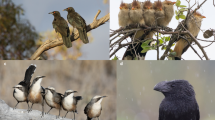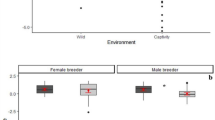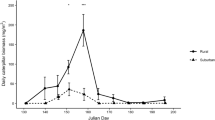Abstract
RECIPROCITY1, or reciprocal altruism2, and kin selection3 are concepts basic to sociobiology. Although both theories have been widely accepted4, little critical evidence exists for either5,6. Communal, or cooperatively breeding, birds are important organisms for testing these theories because nonbreeding helpers regularly provide aid to nestlings, such as food and protection. Helpers are often related to the nestlings they aid, frequently being older siblings7,8, leading some authors to conclude that kin selection is the evolutionary basis for the apparent altruism seen in cooperative breeders8,9. However, the possible influence of other, individual strategies has not been completely separated from kin selection for any communal bird; this would require elimination of kinship ties as a variable5. Aid by a helper to an unrelated young bird must either be considered an ‘accident’ or it suggests that factors other than, or in addition to, kin selection might be the evolutionary bases for helping behaviour, at least in that particular species. Here we report information on a tropical, communal bird, the green wood-hoopoe (Phoeniculus purpureus), that suggests helping is a strategy for personal gain10.
This is a preview of subscription content, access via your institution
Access options
Subscribe to this journal
Receive 51 print issues and online access
$199.00 per year
only $3.90 per issue
Buy this article
- Purchase on Springer Link
- Instant access to full article PDF
Prices may be subject to local taxes which are calculated during checkout
Similar content being viewed by others
References
Alexander, R. D. A. Rev. ecol Syst. 5, 325–382 (1974).
Trivers, R. L. Q. Rev. Biol. 46, 35–57 (1971).
Hamilton, W. D. J. theor. Biol. 7, 1–52 (1964).
Wilson, E. O. Sociobiology (Belknap Press of Harvard University Press, 1975).
Parker, C. Nature 265, 441–443 (1977).
Sherman, P. W. Science 197, 1246–1253 (1977).
Woolfenden, G. E. Auk 92, 1–15 (1975).
Brown, J. L. Am. Zool. 14, 63–80 (1974).
Ricklefs, R. E. Ibis 117, 531–534 (1975).
Woolfenden, G. E. & Fitzpatrick, J. W. Bioscience 28, 104–108 (1978).
Zahavi, A. Ibis 116, 84–87 (1974).
Ligon, J. D. & Ligon, S. H. Living Bird (in the press).
Stallcup, J. A. & Woolfenden, G. E. Anim. Behav. (in the press).
Author information
Authors and Affiliations
Rights and permissions
About this article
Cite this article
LIGON, J., LIGON, S. Communal breeding in green woodhoopoes as a case for reciprocity. Nature 276, 496–498 (1978). https://doi.org/10.1038/276496a0
Received:
Accepted:
Issue Date:
DOI: https://doi.org/10.1038/276496a0
This article is cited by
-
Helping enhances productivity in campo flicker (Colaptes campestris) cooperative groups
The Science of Nature (2015)
-
Kinship reduces alloparental care in cooperative cichlids where helpers pay-to-stay
Nature Communications (2013)
-
Allomaternal Care among the Hadza of Tanzania
Human Nature (2008)
-
A test of alternate hypotheses for helping behavior in white-fronted bee-eaters of Kenya
Behavioral Ecology and Sociobiology (1989)
-
Influence of kinship on helping behavior in Gal�pagos mockingbirds
Behavioral Ecology and Sociobiology (1988)
Comments
By submitting a comment you agree to abide by our Terms and Community Guidelines. If you find something abusive or that does not comply with our terms or guidelines please flag it as inappropriate.



